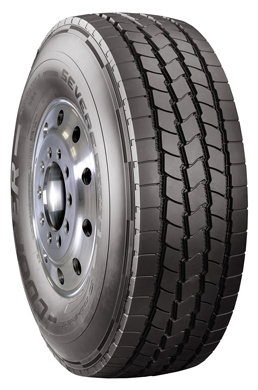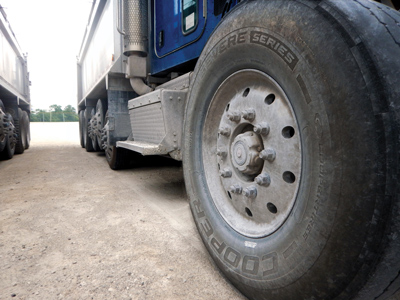Proper tire selection is key to getting the most from your tires, but it is the maintenance practices that keeps your tractors and trailers, and your rear loaders, operating as efficiently and safe as
possible.
By Jason Miller

Photos courtesy of Cooper Tire.
One thing is consistent when it comes to tire maintenance. Tire inflation has been, and always will be, a top concern for fleets. It has been talked about for as long as I have been around commercial tires—close to 40 years. However, keeping consistent inflation levels seems to be a moving target. When doing yard checks with large fleets, I have seen the good and the bad; likewise, with drivers. They have a huge impact since they are supposed to check tires daily—with a gauge, not a thumper.
The best fleets running in the refuse industry—both running transfer dumps, front and rear loaders—have tire inflation well under control, with maintenance technicians that are onboard with the need for accurate pressure checks, maximizing tire life and keeping tire costs under control. Since quality tires that are properly maintained affect longevity, inflation maintenance is a tremendous opportunity to reduce costs. After all, many waste companies run their tires based on months, versus miles. So getting an extra month or two in life can mean some solid returns to your tire program. Following are four tips to ensure a top-tier tire inflation program.
#1: Use Calibrated Gauges
Every shop has gauges, and many drivers do as well. However, the question is, are they accurate? Gauges get dropped, and even if they do not look like it, they are sensitive pieces of equipment. I have tested shop gauges against a master gauge in the past and have found psi readings can be off by 2 to 15 psi. If you are not testing each gauge, and recalibrating them monthly against a master, there is a good chance you are inflating tires to the wrong level. You should have a psi test station set up, along with a master gauge in a highly visible area of the shop. Your techs and drivers need to use it. You simply cannot have a good tire program if you cannot trust your gauges.
#2: Start with the Chart
Most major manufacturers provide load-inflation tables based upon Tire and Rim Association guidelines. For transfer dumps, with a typical 6×4 legal load, there will be 34,000 pounds being carried by eight drive tires, or 4,250 pounds per tire. Drive tires can support that load at as little as 75 psi fully loaded. Yet, many operations run a standard inflation pressure at 100 psi because, they tell us, “That is what we have always done. It is easy to remember, and it gives us more margin for error if a tire leaks.”
For refuse trucks, axle weight limits and axle configurations may vary. For best performance, fleets should adhere to local regulations, scale the trucks at their heaviest—checking for compliance—then check the chart for proper inflation.
So, what is the optimal pressure? Like so many things in life, the answer is, “It depends.” Every tire has a personality. Likewise, every waste hauling operation has a personality. The most cost-effective tire programs come from matching the right tire to the right application at the right inflation pressure. It takes a little time and some discipline, but the effort will pay off.

We need to think differently about air pressure. The reality is, the tire does not actually support the load, the air does. The tire simply contains the air. Through inflation pressure, you are primarily trying to manage two things—the shape of the tire footprint and the amount of sidewall deflection. Overinflation can pose several problems. The biggest is premature removal and ride disturbance due to irregular wear since you are not getting the optimal footprint patch to the road. With the weight concentrated on a relatively small contact patch in the crown of the tire, the shoulders will scrub their way into and then out of the contact patch causing rapid and uneven edge wear. You are also likely to see significant heel-toe wear and increased, ‘road rash’ or chipping of tread rubber in the center ribs. The resulting ride disturbance and general ugliness often result in early removal despite having as much as 30 to 40 percent useable tread remaining. Next, with such a small contact patch, you are compromising traction, and that really comes into play, not only in winter, but also in landfills. You may also see an increase in the occurrence of impact breaks since the tire sidewalls have less flex.
Waste haul operations need to break the cycle and run tires at their proper inflation level, which can be especially challenging given the harsh conditions in which most refuse fleets must operate. Only then, can you get the true performance engineered into the tire, and that will pay you back in the form of a lower cost of ownership. What is the impact if you do not follow the chart? While operations vary significantly, running tires that are just 10 percent underinflated may cause you to remove them from service 10 percent early. At 20 percent underinflated, tread life may be reduced by as much as 25 percent.
#3: Audit Your Inflation Levels
If you are serious about getting your tire costs in check, benchmark where you are at with tire inflation, and identify problem areas. Only then can you take steps to improve your program. For example, what percent of your duals—both on your tractor and trailer—have inflation pressures within 5 psi of each other? Did you know that just a 5 psi difference in inflation between duals is the equivalent of one tire having a circumference that is 5/16-inches smaller? That means during every rotation cycle, the smaller circumference tire must scuff ahead to keep up with the tire with more inflation. These tires rotate around 500 times per mile, so simple math means 500 multiplied by 5/16-inches translates to 156.3-inches per mile, or 13 feet per mile. Imagine dragging a tire 13 feet every mile, under load. How many feet is that per day or per year? This illustrates clearly why you will see increased tire wear with improper pressure.
#4: Tire Related Concerns Beyond Air Pressure
Another area to watch is with retreads. In the waste industries, there are a lot of retreads. It is back to circumference. In some cases, fleets will get identical retreads back from their retreader, but the casings may be different. Each brand and model may have a slightly different diameter, so while two tires will look identical when you get them back from the retreader, one may be significantly taller than the other. You should use a circumference band, good measuring tape or have a height gauge mounted in the shop to check circumference. Otherwise, you may be putting together duals that should be identical but are really mismatched in height and that will cause one tire to wear prematurely.
Get the Most from Your Tires
If these tips are followed and you are running the correct tires for your application, you stand a solid chance of pulling the drive tires at 2/32nds, and the steers at 4/32nds. Your casings should be in great shape for retreading. The way to extend your budget on tires is to get the most miles, coupled with the most retreads. Proper tire selection is one key to doing that, but it is the maintenance practices—especially proper tire inflation—that keeps your tractors and trailers, and your rear loaders operating as efficiently and safely as possible.
Jason C. Miller is Cooper Tire’s (Findlay, OH) National Fleet Channel Sales Manager. He has worked in all aspects of the tire industry, mastering complex tire programs for some of the largest fleets in North America. A member of the Technology and Maintenance Council (TMC) of the American Trucking Associations, Jason is also a TIA Certified Tire Instructor and former ASE certified technician. For more information, visit http://coopertrucktires.com.
